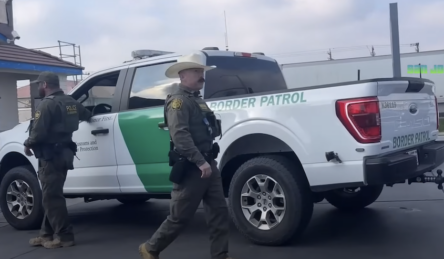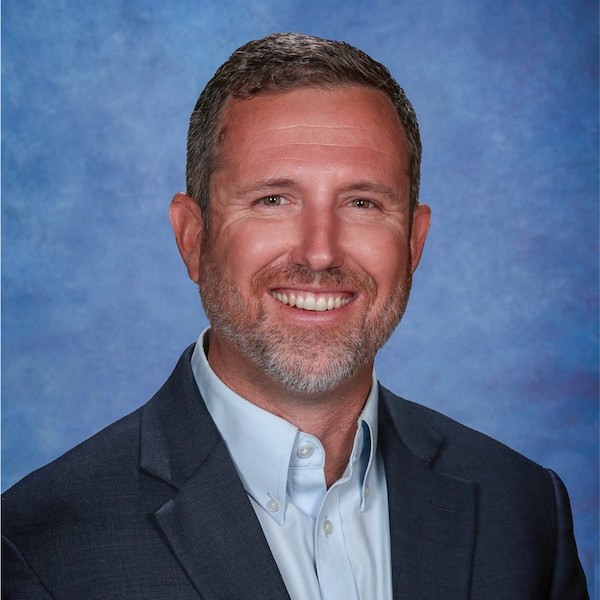
Sergeant Gregory Bovino during an interview at El Centro Border Patrol headquarters on Feb. 25, 2025. Evident YouTube video screenshot
Written by Sergio Olmos and Wendy Fry with CalMatters
This story was originally published by CalMatters. Sign up for their newsletters.
It was quiet on the border. A Border Patrol agent named James Lee was parked in the shade next to a 30-foot fence in Calexico. The windows of his SUV were rolled up, the engine making that noise when it’s idle for a long time while the air conditioning is running. “We haven’t had any crossing in the last few days,” Lee said.
At the height of illegal border crossings in 2023, Border Patrol encountered 3.2 million people. But now the southern border is desolate. Lee is one of around 1,000 agents in the El Centro sector, which has seen a 91% decrease in encounters compared to the same month last year. The decline in crossings that began during the Biden administration has accelerated in the first few months of the Trump administration. When we visited in late February, not a single person had been recorded trying to cross for more than half the week.
The man in charge of the El Centro sector, Gregory Bovino, once told congressional investigators, “I’ve always found that idle hands do the devil’s work.” On Jan. 7, the day after Congress certified Trump’s election victory, Bovino sent 65 of his agents into Kern County, six hours north of the border, to conduct a raid that has shaken immigrant communities and agricultural businesses across the state, and has set the stage for a legal battle over how the government carries out mass deportations.
Border Patrol said it arrested 78 people in what it called “Operation Return to Sender,” but provided few details. Most of the official information about the raid came from Bovino’s Facebook comments. He posted blurred photos of three Latino men alongside a photo of 33 lbs of marijuana in the trunk of a car. He wrote, “Here in the #PremierSector we go the extra mile – or 500 of them – to protect our nation and communities from bad people and bad things.”
On the day of the raids, Casey Creamer, CEO of California Citrus Mutual, an association of citrus growers around Bakersfield, heard that the Border Patrol was targeting criminal activity. He thought that might explain why the agents had come so far north. But the next day, he began to doubt the official narrative.
“It does not seem to be a targeted criminal activity just based on what growers are seeing and observing,” he said.
Creamer learned that agents detained people outside of a Home Depot and a convenience store frequented by farm workers in the morning on their way to the fields. They pulled over drivers on roads running between farms.
“I know for a fact they were stationed on growers’ property. Not public property, but actual growers’ property,” Creamer said.
Bovino said that his agents had a “predetermined list of targets,” many of whom had criminal records, before they set off for Kern County. “We did our homework,” he said.
But a CalMatters investigation, in partnership with Evident and Bellingcat, found that Border Patrol officials misrepresented the very basics of their high-profile, large-scale immigration raid. Data obtained from U.S. Customs and Border Protection reveal that Border Patrol had no prior knowledge of criminal or immigration history for 77 of the 78 people arrested.
In a spreadsheet provided by the agency, under “Criminal History,” all but one entry contains the following passage: “Criminal and/or immigration history was not known prior to the encounter.”
***
Bovino sat down with CalMatters in February to talk about the Kern County operation.
A handful of armed agents stood as audience for the entire hour. They stayed quiet, listening to their boss tell a reporter what’s what.
Bovino stands out among the Border Patrol chiefs. The El Centro sector’s Facebook page features staged photos of him in uniform, including including a closeup with an AR-15, and one on a white horse in the desert, cradling a shotgun. He has given his sector a brand: “the premier sector.” It’s similar to the way states have mottos on license plates that aren’t necessarily used by anybody else to describe that state.
“Twenty sectors in the U.S. Border Patrol, and we do call ourselves the premiere sector,” he said with a smile. “So please let those other chiefs know we said that.”
This area of the border is remote. But Bovino’s powers stretch far beyond the border. “Our area goes up through Central California, all the way to the Oregon border,” he said.
U.S. Customs and Border Protection has the authority to search vehicles and vessels without a warrant “within a reasonable distance from any external boundary” of the U.S., including the entire coastline. The federal government defines this distance as 100 miles.
Roughly two-thirds of the U.S. population, about 200 million people, live within this zone.
“Federal authority does not just reside at that line in the sand, as some people like to look at it on the border,” Bovino said. “A lot of bad things and bad people that come across that border. And it doesn’t just stay at the border. What comes across that border goes into Anytown, USA and into Ma’ and Pa’ America.”
Nationwide there are roughly four times more Border Patrol than ICE agents. In El Centro, there are five Border Patrol agents whose job it is to produce videos.
Their latest project is a series of fictionalized videos portraying migrants crossing the border as menaces with a bloodlust to commit crimes. Bovino shared the first video on social media with the caption: “Any town. Any neighborhood. Any family. When heartless criminals, sex offenders, and human traffickers illegally enter the United States and get away, they prey on our children, the most vulnerable members of our communities.”
In the video, two agents sit in their vehicle at night, listening to a news broadcast about an undocumented migrant charged with the rape and murder of a 64-year-old woman in Santa Maria. The news clip is from a real CBS report from 10 years ago. An agent shakes his head in disgust and turns off the radio, saying “Man, that’s the second one in less than a week. Things are getting out of hand.”

At that moment dispatch comes over the radio and tells the agents of a nearby vehicle that’s loaded with migrants. The agents are able to catch three of the men, but one gets away and sneaks into “Anytown, USA,” where he savagely murders an American citizen, taking the man’s cell phone and fleeing. The screen goes dark with the message: “Every apprehension matters. Do you know who got away?”
Bovino is proud of the videos, and rejected the idea that the fictional portrayals are, in fact, fictional. “Those fictionalized accounts that you’re talking about are really not fictionalized accounts. Let’s get that straight. Because thousands of American citizens every year die and/or are maimed, killed or raped,” he said. Less than 1% of the people Border Patrol agents encounter have a criminal conviction of any kind, according to agency data. By comparison around 8% of Americans have a felony conviction, according to one study.
Bovino likes to praise President Dwight Eisenhower, who led the largest deportation in American history, rounding up 1.3 million Mexicans and Mexican Americans in 1954. The first buses deporting migrants – in what was called “Operation Wetback” – rolled out of El Centro over 70 years ago. In January, Bovino launched his own operation as “a proof of concept,” he has said, to show how Border Patrol could be used for mass deportations in the interior.
***
The El Centro sector denied requests for details on the 78 people arrested during “Operation Return to Sender.” CalMatters made the same request to Customs and Border Protection headquarters in Washington, D.C., which provided the data. It showed the Border Patrol had a record of criminal or immigration history on only one person. That person’s record showed that they had been ordered to be deported a year earlier.
The records directly contradict what Bovino told us in the interview. He maintained his agents went after specific targets, “many of which … were prior deports, already had immigration history, criminal history.”
We received the data after our interview with Bovino. We attempted to ask the Border Patrol follow-up questions, but the agency declined, citing “ongoing litigation.” Last month the ACLU sued Border Patrol on behalf of United Farm Workers, arguing that the agency detained people who looked Latino or like farm workers without reasonable suspicion they were doing anything unlawful, and then deprived them of due process by forcing them to sign self-deportation paperwork.
In our interview, Bovino also offered an expansive definition of who he considers “criminals.”
“Every single one of the 78 that we arrested were criminals. Eight U.S.C. 1325 – illegal entry into the United States,” he said, citing federal code for what is a misdemeanor offense.
If the Border Patrol did have a targeted list of people with criminal records, they didn’t arrest them. Regardless, Bovino didn’t see a difference between going after undocumented field workers or drug dealers: “If you’re an illegal alien, you’re getting it. A fentanyl dealer, you get it.”

Creamer, who represents the citrus growers, said he has a different definition of criminal activity.
He said the people who work in their operations have been there as long as 30 years – “ hard-working people that don’t deserve to be harassed.”
“If they’re targeting a rural operation like this, people that are getting up early in the morning to work, those aren’t drug dealers,” he said.
Creamer warned that the United States won’t have a food supply if agriculture doesn’t have a workforce in California and beyond. The USDA Economic Research services says that 42% of agricultural workers are undocumented. Lawmakers in Florida, which is the other major citrus provider, recently introduced legislation to loosen child labor laws to replace field workers following an immigration crackdown.
Ninety percent of the nation’s fresh citrus comes from California, according to Citrus Mutual. Zac Green, a citrus farmer in Kern County, said that, in the days after the raid, 85 percent of his workers stayed home out of fear. “We have to have that reliable workforce,” he said. “We’re feeding people.”
“Our people can go back to their communities and put their kids in school. They can buy homes, they can buy vehicles,” he said. “We’re here to work and provide for our families, and that’s what we’re trying to do.”
Bree Bernwanger, a senior staff attorney with the ACLU, said she’s not surprised that Border Patrol had prior records on only one of the people arrested.
“Border Patrol went on a fishing expedition in the Central Valley. They swarmed the highways and stopped people in agricultural areas,” she said. “People who are just driving down the road because they were brown or because they looked like farm workers. ”
The ACLU has asked for a restraining order to stop the agency from conducting similar raids within California while the lawsuit is being heard. The organization argues that Border Patrol must have reasonable suspicion a person is doing something unlawful.
“We’re asking a court to order them not to stop people – whether they’re driving down the road or whether they’re in a parking lot – not to stop them unless they have a reason,” Bernwanger said. “And someone looking Latino, looking like a farm worker, looking like a day laborer—those are not legal reasons.”

For his part, Bovino wants to use the Kern operation as a model for immigration enforcement across California.
“It’s game on – anywhere,” he said.
“It could be Fresno, could be Sacramento, could be Stockton. You never know. We’re going to go where that threat is, and where we can do the most damage to bad people and bad things that we possibly can. That’s what we’re in the business of doing.”







